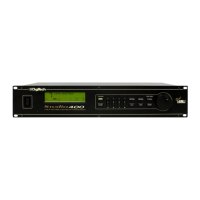9
Section 2 - Basic Function of the Studio 400
Studio 400 Owner's Manual
SECTION 2 - BASIC FUNCTIONS OF THE STUDIO 400
GETTING AROUND THE OPERATING SYSTEM
The menu structure of the Studio 400 has been specially designed to be easy to use. The display shows
the information you need, but to make things even easier for you, illumination in the front panel buttons
offers additional operating information.
The front panel buttons give you information in one of two ways:
1 - If the button is not lit, its function is INACTIVE. Pressing an unlit button causes it to light brightly
and its function becomes the active item in the display. If the unlit button doesn’t light after you
press it, the button is unavailable.
2 - If the button is lit, its function is ACTIVE. Pressing an active button (other than the <PROGRAM>
button) reselects the already active item in the display.
PROGRAM MODE - Program mode allows you to scroll through the Factory and User Programs using the
Data Wheel. When the Studio 400 is turned on, it sets itself to Program mode. Program mode is active
when the <PROGRAM> button is lit and a Program name is present on the Information line (top line) of the
display. You can toggle between Factory or User Programs by pressing and holding the <PROGRAM>
button when it is lit. The FACTORY PRG or USER PRG indicator will light in the display according to which
bank is selected. In this mode, all other buttons on the front panel are dim or off.
To select a Program, do the following:
• Make sure Program mode is selected. If the <PROGRAM> button is dim, press <PROGRAM> once
to return to Program mode.
• Use the <PROGRAM> button to select the Program bank (Factory or User). Each successive press
of the <PROGRAM> button toggles between the Factory and User bank of Programs.
• Using the Data wheel, scroll to the Program you want to hear.
The selected program is immediately autoloaded. The AutoLoad feature can be turned off, allowing you to
view a program before actually loading it. See pg. 34 for further details.
FX EDIT MODE - This mode allows you to edit: 1. FX Modules, 2. the Modifier Module, 3. the Input Mode
Module, and 4. the Output Mode Module of your Programs. Use the <FX Edit> button to enter the FX Edit
mode and then to select the next module for editing. A helpful hint: If you look at the Effect Routing Matrix
while you press the FX Edit button, the currently selected module will flash. The Studio 400 uses Pages to
navigate within an effect. A Page is a group of up to four effect Parameters that appear on the screen at
one time. To move through the Pages in a Program, use the <NEXT PAGE> and <PREV PAGE> buttons.
Note that as you scroll through the Pages, the Page indicator in the lower left corner of the display
changes to show the currently displayed Page.
SELECTING FX TYPES AND DEFAULTS
The Studio 400 has made custom digital signal processing easier than ever by giving you access to a com-
plete library of professionally developed effects settings. Page one of every FX Module allows you to:
1) Bypass that effect module
2) Select an effect Type (Chorus, Reverb, Delay, etc.)
3) Select a Default for the selected effect Type
The Default parameter allows you to select one of several effect settings stored in the Studio 400's library.
For example, there are 9 Dual Delay defaults to choose from. All Factory Programs use these Default set
tings. So, if you like the Delay that is being used in Factory Program 11, simply locate page one of the FX
Module, then use the <4> button and the Data Wheel to recall the default (which happens to be A2-
Pingpong2) in your new program. This eliminates the need to copy all those parameters from one location

